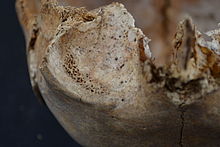Tombos (Nubia)
[7] The British Museum carried out an epigraphic survey at Tombos, which is a part of larger project of investigating Egyptian inscriptions in northern Sudan.
The Inscription is located on the east bank of the Nile, on the northern side of a low-lying boulder of granite gneiss, only several meters from the great stela of Thutmose I.
The first is characterized by elite pyramid monuments and is situated in the southwestern area of the site; the second are underground chamber tombs of the less wealthy, located to the north.
The first is a pyramid monument of Siamun and his wife, Weren (Unit 1 and 4), who is “Scribe Reckoner of the Gold of Kush”, this title indicates his was a high-ranking official only second to the viceroy and military commander of the Nubian colony .
[5] The structure of Siamun's tomb followed the burial tradition of the Egyptian elite from Thebes, including a large pyramid and a T-shaped chapel with an east-west alignment set into it.
His funerary cone is not as elaborate as Siamun's, it is a simple stamp only has Tiy's hieroglyphic name on it, indicating that it was an adaptation but not the conventional form of Theban practice.
A poorly preserved but very high-quality coffin with inlaid faience was found in Tiy's tomb, as well as a sophisticated carved funerary figurine (ushabti) with his name and title on it.
[5] The third is a complex with chapels around the shaft of the tomb, owned by Horemhet, but no trace of the pyramid remains, and it also contains the funerary cones from Theban tradition, but in a simplified form.
Underground chamber and pit tombs were designed for multiple inhumation, and belonged to middle-class individuals, probably the lower-ranking bureaucrats and other skilled workers.
The burial objects, such as coffins, amulets, and statuary are consistent with Egyptian funerary beliefs, and Nubian personal adornment like ivory bracelets and earrings were also found.
Osteological analysis shows evidence for the use of chariot saddle harness, as well as suggests that the horse engaged in regular and somewhat strenuous physical activity.
[11]The traumatic injuries observed at Tombos provide insights into the effects of Egyptian colonial policies on local Nubian populations.
In the Middle Kingdom, Egypt launched aggressive campaigns against the Nubian community at Kerma, intensifying conflicts and leading to high rates of skeletal injuries.
[12] At Tombos, skeletal analysis shows fewer cases of cranial trauma and defensive injuries, such as “parry” fractures, which are usually associated with interpersonal violence.
The decrease in traumatic injuries at Tombos indicates a shift toward cooperation and integration, as Egypt’s colonial strategy in the New Kingdom period involved collaboration with local Nubian elites.
This more cooperative approach contributed to a more peaceful environment at Tombos, demonstrating that partnerships with the local population were effective in supporting Egypt’s economic and political goals.
The Tombos population's closeness to Egyptian resources and trade networks helped to provide nutritional benefits, like higher access to cattle and other livestock.
Even though the people of Tombos were part of the Egyptian colonial system, their health outcomes show that having those ties did not help with the environmental and biological challenges they faced.
Archaeologists found the negative impression of beams and roofing, some fragments showing a finished floor above the ceiling, and a sandstone column base hinting at the existence of a clerestory or portico.
